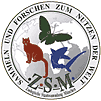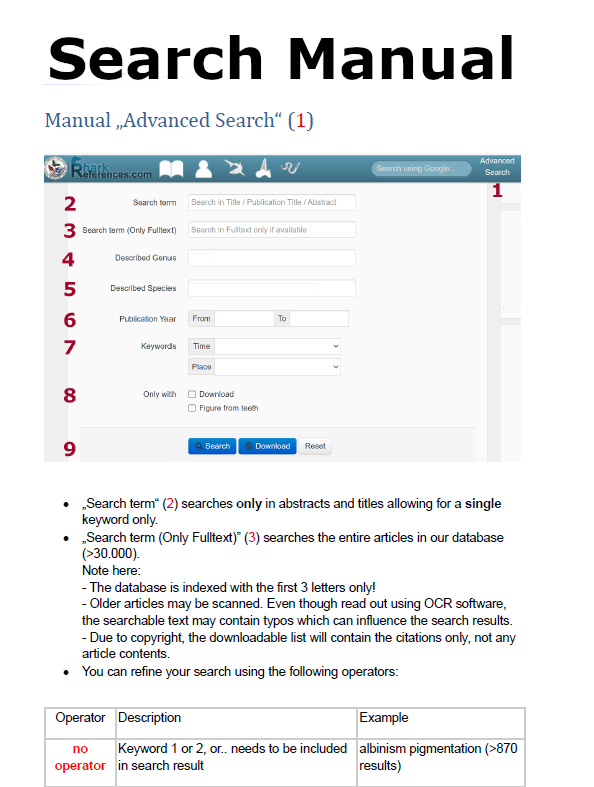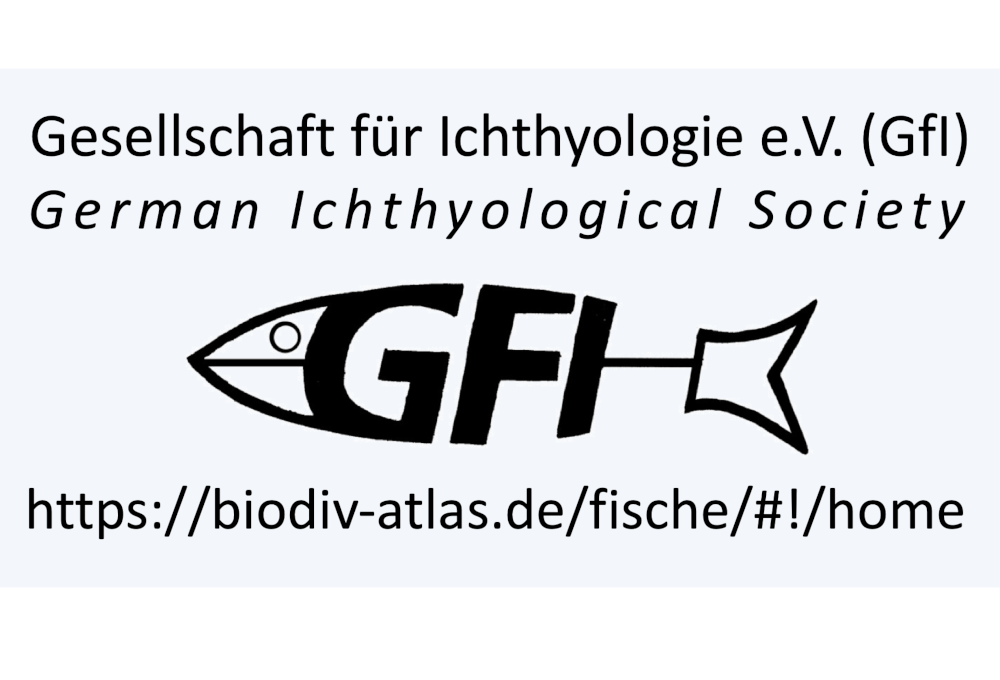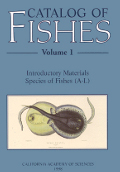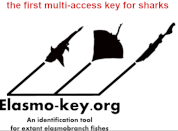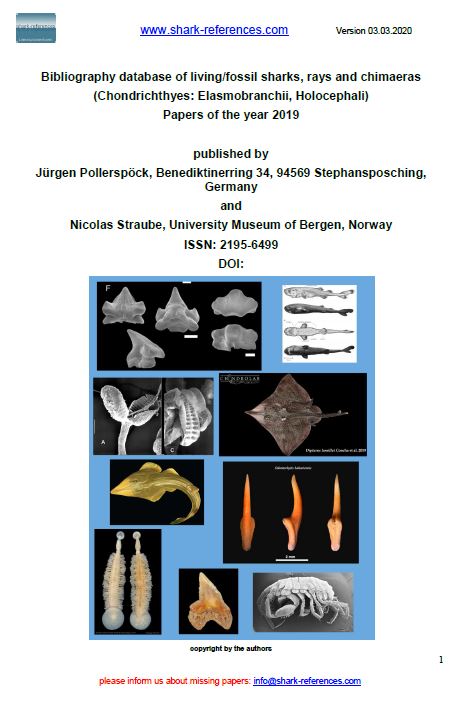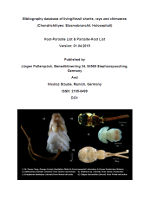The homologies of the muscles related to the visceral arches of the gnathostome fishes. Quarterly Journal of Microscopical Science, 62, 303–406
Révision critique des cestodes tétraphyllides décrits par T. Southwell. Bulletin de la Société Neuchâteloise des Sciences Naturelles, 71, 63–122
Revision critique des cestodes tétraphyllides décrits par T. Southwell. Bulletin de la Société Neuchateloise des Sciences Naturelles, 85, 143–172
DOI: 10.5169/seals-88925

Contribution a l'étude des poissons de l'Ile Maurice. VIII. Proceedings of the Royal Society of Arts and Sciences of Mauritius, 2(2), 162–189

Shark tagging in the Eastern Pacific Ocean, 1962-65. In P.W. Gilbert, R.F. Mathewson, & D.P. Rall, (Eds.), Sharks, skates and rays. (pp. 93–109). John Hopkins Press, Baltimore

Knorpelfische (Chondrichthyes) aus dem tropischen Ostatlantik. Atlantide Report, (10), 33–76

Revised list of the Mediterranean fishes of Israel. Israel Journal of Zoology, 20, 1–39
DOI: 10.1080/00212210.1971.10688323

Note preliminaire sur le marquage de Selaciens des cotes de Tunisie. Bulletin de l'Institut National Scientifique et Technique d'Oceanographie et de Peche de Salammbo, 2(2), 143–155

Analysis and description of variation in the proportional dimensions of scyliorhinid, carcharhinid and sphyrnid sharks. South African Association for Marine Biological Research, Oceanographic Research Institute, Investigational Report, 32, 1–28
An annotated bibliography of parasitic Isopoda (Crustacea) of Chondrichthyes. Brazilian Journal of Oceanography, 27(2), 95–152
DOI: 10.1590/S1679-87591978000200005


Sharks of the order Carcharhiniformes. Princeton University Press, New Jersey 1988

Measurement of monoamines and monoamine metabolites in various brain regions of six shark species. Comparative Biochemistry and Physiology – Part C, Comparative Pharmacology, 94(2), 493–498
DOI: 10.1016/0742-8413(89)90103-5
Deep-sea elasmobranchs observed from submersibles off Bermuda, Grand Caymen, and Freeport, Bahamas. In Pratt, H.L., Gruber, S.H., Taniuchi, T., editors. Elasmobranchs as living resources: advances in the biology, ecology, systematics, and the status of the fisheries: NOAA Technical Report NMFS, 90: 269–284

Distribution, size and sex composition, reproductive biology and diet of sharks from northern Australia. Australian Journal of Marine and Freshwater Research, 42(2), 151–199
DOI: 10.1071/MF9910151
Cataloghi del Museo di Storia Naturale dell'Universita di Firenze, Sezione di Zoologia “La Specola”. XI. Chondrichthyes. Atti della Societa Toscana di Scienze Naturali, Serie B, 99, 85–114

I Leptocardi, Ciclostomi e Selaci delle collezioni del Museo Civico di Storia Naturale di Venezia - 1) Leptocardia, Agnatha, Gnathostomata - Chondrichthyes (esclusi Rajiformes). Bollettino del Museo civico di Storia Naturale di Venezia, 45, 123–137

Status of shark resources in the Southern Gulf of Mexico and Caribbean: implications for management. Fisheries Research, 29(2), 101–117
DOI: 10.1016/S0165-7836(96)00536-X

Analysis of Calliobothrium (Tetraphyllidea: Onchobothriidae) with descriptions of three new species and erection of a new genus. Journal of Parasitology, 83(4), 714–733
Assessment of groundfish stocks in northern Australian waters between 127–137°E. Final report to the Fisheries Research and Development Corporation on project 90/15, and the Fisheries Management Authority. Department of Primary Production, Northern Territory, Fishery Report, 38: 1–85

Part Sharks: Hexanchidae, Echinorhinidae, Squalidae, Squatinidae, Heterodontidae, Parascyllidae, Bracheluridae, Orectolobidae, Hemiscyllidae, Odontaspididae, Scyliorhinidae, Proscyllidae, Triakidae, In K.E. Carpenter and V.H. Niem(eds.), FAO Identification Guide for Fishery Purposes. The Living Marine Resources of the Western Central Pacific. Food and Agriculture Organization, Rome: 1195–1232, 1235–1259, 1264–1267, 1279–1295, 1297–1304, 1312–1360

Keeping the fish in ‘fish and chips': research and management of the Western Australian shark fishery Marine and Freshwater Research, 49(7), 593–600
DOI: 10.1071/MF97043
Checklist of the fishes of Western Australia. Records of the Western Australian Museum, Supplement 63, 9–50

Taxonomic affinities within Australian and New Zealand Mustelus sharks (Chondrichthys: Triakidae) inferred from allozymes, mitochondria DNA and precaudal vertebrae counts.l. Copeia, 2002(2), 356–363

An overview of the elasmobranch by-catch of the Queensland East Coast Trawl Fishery (Australia). NAFO Scientific Research Council Document 02/97

New Records of Elasmobranch Species from Sabah. In Elasmobranch Biodiversity, Conservation and Management. Proceedings of the conference on Shark and Ray Biodiversity, Conservation and Management, Sabah, Malaysia, July 1997. IUCN, Gland, Switzerland: 70–77
Field identification guide to Western Australian Sharks and Shark-like Rays. Fisheries Occasional Publications, 1: 1–25
The Conservation Status of Australasian Chondrichthyans. Report of the IUCN Shark Specialist Group Australia and Oceania Regional Red List Workshop. The University of Queensland, School of Biomedical Sciences, Brisbane, Australia
Sharks captured off Pescara (Italy, western Adriatic Sea). Annales, Series Historia Naturalis, 13(2), 201–208

Collection of the sharks of the National Museum in Prague - Part 1. Complete taxiderms and liquid preservations. Journal of the National Museum, Natural History Series, 172(1–4), 61–70

Reported siphonostomatoid copepods parasitic on marine fishes of southern Africa. Crustaceana, 77(11), 1281–1328

The Trypanorhyncha Diesing, 1863. PKSPL–IPB Press ISBN 979–9336–39–2

Phylogenetic trends in the abundance and distribution of pit organs of elasmobranchs. Acta Zoologica(Stockholm), 85(4), 233–244
DOI: 10.1111/j.0001-7272.2004.00176.x

Collection of the sharks of the National Museum in Prague - Part 2. Skeletal preservations. Journal of the National Museum, Natural History Series, 173(1–4), 51–58

North Sea elasmobranchs: distribution, abundance and biodiversity. ICES CM Documents 2005, 6, 1–15

Aspectos biológicos y pesqueros de elasmobranquios capturados en el Parque Nacional Natural Gorgona y su área de influencia entre 2004 y 2005. Thesis, FUNDACIÓN UNIVERSIDAD JORGE TADEO LOZANO, FACULTAD DE BIOLOGÍA MARINA, BOGOTÁ

Elasmobranchs in trammel net fishery associated to marine reserves in the Balearic Islands (NW Mediterranean). Cybium, 30(4, Supplement), 125–132

An analysis of the recreational shore fishery in the Goukamma Marine Protected Area. African Zoology, 41(2), 275–289
DOI: 10.3377/1562-7020(2006)41[275:aaotrs]2.0.co;2

Northern Australian sharks and rays: the sustainability of target and bycatch species, Phase 2. Final Report to FRDC Project No. 2002/064. 183 pp.
The MEDLEM Database Application: A Tool for Storing and Sharing the Large Shark’s Data Collected in the Mediterranean Countries. In N. Başusta, Ç. Keskin, F. Serena & S. Bernard (Eds.), International workshop on Cartilaginous fishes in the Mediterranean. (pp. 118-127). Turkish Marine Research Foundation, Istanbul

The Danish fish fauna during the warm Atlantic period (ca. 7000-3900 BC): Forerunner of future changes? Fisheries Research, 87(2–3), 167–180
DOI: 10.1016/j.fishres.2007.03.004

Tubarões (Selachii) coletados pelo navio oceanográfico Thalassa sobre a plataforma externa e talude continental do Brasil entre 11° e 22°S. In, Paulo A.S. Costa, George Olavo, Agnaldo S. Martins(eds), Biodiversidade da fauna marinha profunda na costa central brasileira. Rio de Janeiro, Museu Nacional(Série Livros n.24), 163–

Long-term trends in the competitive shore fishery along the KwaZulu-Natal coast, South Africa. African Zoology, 42(2), 216–236
DOI: 10.3377/1562-7020(2007)42[216:LTITCS]2.0.CO;2

Authorship, availability and validity of fish names described by Peter (Pehr) Simon Forsskål and Johann Christian Fabricius in the 'Descriptiones animalium' by Carsten Niebuhr in 1775 (Pisces). Stuttgarter Beiträge zur Naturkunde A, Neue Serie, 1, 1–76

Temporal variation in the artisanal elasmobranch fishery of Sonora, Mexico. Fisheries Research, 97(1–2), 103–117
DOI: 10.1016/j.fishres.2009.01.009

Sharks, skates and rays in the northeast Atlantic: population status, advice and management. Journal of Applied Ichthyology, 25(S1), 3–8
DOI: 10.1111/j.1439-0426.2008.01069.x

Observer-based study of targeted commercial fishing for large shark species in waters off northern New South Wales. Northern Rivers Catchment Management Authority, Project No. IS8–9–M–2, Industry & Investment NSW
Distributions of Sharks across a Continental Shelf in the Northern Gulf of Mexico. Marine and Coastal Fisheries, 2(1), 440–450
DOI: 10.1577/c09-061.1
Deep-sea fishing for chondrichthyan resources and sustainability concerns - a case study from southwest coast of India. Indian Journal of Geo Marine Sciences, 40(3), 347–355

Bycatch in South Africa's inshore trawl fishery as determined from observer records. ICES Journal of Marine Science, 68(10), 2163–2174
DOI: 10.1093/icesjms/fsr162

The artisanal elasmobranch fishery of the Pacific coast of Baja California, Mexico. Fisheries Research, 108(2–3), 393–403
DOI: 10.1016/j.fishres.2011.01.020

Applying genetic techniques to study remote shark fisheries in northeastern Madagascar. Mitochondrial DNA, 22(Suppl 1), 15–20
DOI: 10.3109/19401736.2010.526112

A checklist of parasitic nematodes from marine fishes of China. Systematic Parasitology, 79(1), 17–40
DOI: 10.1007/s11230-010-9288-1
Review of research and monitoring studies on New Zealand sharks, skates, rays and chimaeras, 2008-2012. New Zealand Aquatic Environment and Biodiversity Report, 102: 70 p.

Modelled distributions of ten demersal elasmobranchs of the eastern English Channel in relation to the environment. Journal of Experimental Marine Biology and Ecology, 418–419, 91–103
DOI: 10.1016/j.jembe.2012.03.010
A DNA sequence based approach to the identification of shark and ray species and its implications for global elasmobranch diversity and parasitology. Bulletin of the American Museum of Natural History, 367, 1–262

Phylogenetic analysis and reconfiguration of genera in the cestode order Diphyllidea. International Journal for Parasitology, 43(8), 621–639
DOI: 10.1016/j.ijpara.2013.03.001
Long-term trajectory of some elasmobranch species off the Tuscany coasts (NW Mediterranean) from 50 years of catch data. Scientia Marina, 77(1), 119–127
DOI: 10.3989/scimar.03654.21C

The artisanal elasmobranch fishery of the Pacific coast of Baja California Sur, Mexico, management implications. Scienta Marina, 77(3): 473–487

Adaptive Capacity of Fishing Communities at Marine Protected Areas: A Case Study from the Colombian Pacific Ambio, 42(8), 985–996
DOI: 10.1007/s13280-013-0454-y

The role of fisheries and the environment in driving the decline of elasmobranchs in the northern Adriatic Sea. ICES Journal of Marine Science, 71(7), 1593–1603
DOI: 10.1093/icesjms/fst222
Big catch, little sharks: Insight into Peruvian small-scale longline fisheries. Ecology and Evolution, 4(12), 2375–2383
DOI: 10.1002/ece3.1104

What barcode sequencing reveals about the shark fishery in Peru. Fisheries Research, 161, 34–41
DOI: 10.1016/j.fishres.2014.06.005

Fish abundance, fisheries, fish trade and consumption in sixteenth-century Netherlands as described by Adriaen Coenen. Fisheries Research, 161, 384–399
DOI: 10.1016/j.fishres.2014.09.001

Family Triakidae, Houndsharks and smooth-hounds In The Fishes of New Zealand, (ed) Clive D Roberts, Andrew L Stewart, Carl D Struthers, vol. 2, Systematic Accounts: 93–96
Guidance on National Plan of Action for Sharks in India. CMFRI Marine Fisheries Policy Series(2): 1–102
Recent collections of fishes at the Kermadec Islands and new records for the region. Bulletin of the Auckland Museum, 20, 463–480

Fishing in the northern Maya lowlands AD 250-750: preliminary analysis of fish remains from Xcambo, Yucatan, Mexico. Environmental Archaeology, 21(2), 172–181
DOI: 10.1080/14614103.2015.1118176

Evaluating support for shark conservation among artisanal fishing communities in Costa Rica. Marine Policy, 71, 1–9
DOI: 10.1016/j.marpol.2016.05.005

Distribution of skates and sharks in the North Sea: 112 years of change. Global Change Biology, 22(8), 2729–2743
DOI: 10.1111/gcb.13316

Social, economic and trade characteristics of the elasmobranch fishery on Unguja Island, Zanzibar, East Africa. Marine Policy, 83, 128–136
DOI: 10.1016/j.marpol.2017.06.002

Assessing the small-scale shark fishery of Madagascar through community-based monitoring and knowledge. Fisheries Research, 186(1), 131–143
DOI: 10.1016/j.fishres.2016.08.012
The sharks and rays of the Solomon Islands: a synthesis of their biological diversity, values and conservation status. Pacific Conservation Biology, 23(4), 324–334
DOI: 10.1071/PC17012

Molecular research on the systematically challenging smoothhound shark genus Mustelus: a synthesis of the past 30 years. African Journal of Marine Science, 39(4), 373–387
DOI: 10.2989/1814232x.2017.1394365
Remote electronic monitoring as a potential alternative to on-board observers in small-scale fisheries. Biological Conservation, 219, 35–45
DOI: 10.1016/j.biocon.2018.01.003

Tetraphyllidean and onchoproteocephalidean cestodes of elasmobranchs from Moreton Bay, Australia: description of two new species and new records for seven described species. Systematic Parasitology, 95(8–9), 807–827
DOI: 10.1007/s11230-018-9817-x
Conservation status of New Zealand chondrichthyans (chimaeras, sharks and rays), 2016. New Zealand Department of Conservation
Species composition of the international shark fin trade assessed through a retail-market survey in Hong Kong. Conservation Biology, 32(2), 376–389
DOI: 10.1111/cobi.13043

Management of deep-water sharks' by-catch in the Portuguese anglerfish fishery: from EU regulations to practice. Marine Policy, 90, 55–67
DOI: 10.1016/j.marpol.2018.01.006

Official catch data underrepresent shark and ray taxa caught in Mediterranean and Black Sea fisheries. Marine Policy, 105, 1–9
DOI: 10.1016/j.marpol.2019.02.041
Parasites of cartilaginous fishes (Chondrichthyes) in South Africa - a neglected field of marine science. Folia Parasitologica, 66, Article 002
DOI: 10.14411/fp.2019.002
Marine megafauna catch in southwestern Indian Ocean small-scale fisheries from landings data. Biological Conservation, 230, 113–121
DOI: 10.1016/j.biocon.2018.12.024

Assessment of trends in the Portuguese elasmobranch commercial landings over three decades (1986-2017). Fisheries Research, 230, Article 105648
DOI: 10.1016/j.fishres.2020.105648

Marine and estuarine leeches (Hirudinida : Ozobranchidae and Piscicolidae) of Australia and New Zealand with a key to the species. Invertebrate Systematics, 34(3), 235–259
DOI: 10.1071/is19048
Species composition of the largest shark fin retail-market in mainland China. Scientific Reports, 10, Article 12914
DOI: 10.1038/s41598-020-69555-1
Defining Sex-Specific Habitat Suitability for a Northern Gulf of Mexico Shark Assemblage. Frontiers in Marine Science, 7, Article 35
DOI: 10.3389/fmars.2020.00035
DNA Barcoding for the Assessment of the Taxonomy and Conservation Status of the Fish Bycatch of the Northern Brazilian Shrimp Trawl Fishery. Frontiers in Marine Science, 7, Article 566021
DOI: 10.3389/fmars.2020.566021
Architectural and ultrastructural features of tessellated calcified cartilage in modern and extinct chondrichthyan fishes. Journal of Fish Biology, 98(4), 919–941
DOI: 10.1111/jfb.14376
Importance of recreational shore angling in the archipelago of Madeira, Portugal (northeast Atlantic). Scientia Marina, 84(4), 331–341
DOI: 10.3989/scimar.05046.30A

Fishing down the reef slope: Characteristics of the nearshore deepwater fisheries of MesoAmerica. Ocean & Coastal Management, 211, Article 105773
DOI: 10.1016/j.ocecoaman.2021.105773

Sharks in hot soup: DNA barcoding of shark species traded in Singapore. Fisheries Research, 241, Article 105994
DOI: 10.1016/j.fishres.2021.105994

Biomass of slow life history species increases as local bottom trawl effort decreases in the Celtic sea. Journal of Environmental Management, 290, Article 112634
DOI: 10.1016/j.jenvman.2021.112634
Rebound in functional distinctiveness following warming and reduced fishing in the North Sea. Proceedings of the Royal Society of London, Series B, 288(1942), Article 20201600
DOI: 10.1098/rspb.2020.1600
A closer look at the bycatch of medium-sized and large sharks in the northern Catalan coast (north-western Mediterranean Sea): Evidence of an ongoing decline? Aquatic Conservation, Marine and Freshwater Ecosystems, 31(9), 2369–2380
DOI: 10.1002/aqc.3651

New technologies can support data collection on endangered shark species in the Mediterranean Sea. Marine Ecology Progress Series, 689, 57–76
DOI: 10.3354/meps14030
What Is in Your Shark Fin Soup? Probably an Endangered Shark Species and a Bit of Mercury. Animals, 12(7), Article 802
DOI: 10.3390/ani12070802

Biological parameters and spatial segregation patterns in sharks from the North Aegean Sea, Greece. Marine and Freshwater Research, 73(11), 1378–1392
DOI: 10.1071/mf22079
Molecular identification and first demographic insights of sharks based on artisanal fisheries bycatch in the Pacific Coast of Colombia: implications for conservation. PeerJ, 10, Article e13478
DOI: 10.7717/peerj.13478

Integrating long-term citizen science data and contemporary artisanal fishery survey data to investigate recreational and small-scale shark fisheries in Kenya. Aquatic Conservation, Marine and Freshwater Ecosystems, 32(8), 1306–1322
DOI: 10.1002/aqc.3829

Ornament, Weapon, or Tool? Microwear Analysis of Shark Teeth from the Rio Do Meio Site in Florianopolis, Brazil. Latin American Antiquity, 34(4):857-872
DOI: 10.1017/laq.2022.78
DNA-based species identification of shark fins traded in thai markets. Conservation Genetics, 24, 537–546
DOI: 10.1007/s10592-023-01519-0
Influence of ecological traits on spatio-temporal dynamics of an elasmobranch community in a heavily exploited basin. Scientific Reports, 13(1), Article 9596
DOI: 10.1038/s41598-023-36038-y
Checklist of the Fishes of New Zealand. Online version 2.0 Museum of New Zealand Te Papa Tongarewa, version 2.0 April 2023, 282 p.
Marine megafauna catch in Thai small-scale fisheries. Aquatic Conservation, Marine and Freshwater Ecosystems, 33(11), 1245–1262
DOI: 10.1002/aqc.3989
Darwin, Haeckel, and the “Mikluskan gas organ theory” Developmental Dynamics, 253(4), 370–389
DOI: 10.1002/dvdy.661
Small sharks, big problems: DNA analysis of small fins reveals trade regulation gaps and burgeoning trade in juvenile sharks. Science Advances, 10(42), Article eadq6214
DOI: 10.1126/sciadv.adq6214

Elasmobranch diversity around the southern Caribbean island of Tobago: opportunities for conservation in a regional trade hub. Journal of the Marine Biological Association of the United Kingdom, 104, Article e8
DOI: 10.1017/s0025315423000917

Integrating historical and recent information to understand chondrichthyan dynamics in the central Mediterranean. Marine Environmental Research, 197, Article 106468
DOI: 10.1016/j.marenvres.2024.106468

Schwimmblase oder Lunge? Lichtgedanken, 13, 56–57
Northeast Atlantic species distribution shifts over the last two decades. Global Change Biology, 30(6), Article e17383
DOI: 10.1111/gcb.17383
Beneath the surface: DNA barcoding of shark fins in Singapore. Royal Society Open Science, 11(9), Article 240532
DOI: 10.1098/rsos.240532
An Annotated Checklist of Monogeneans (Platyhelminthes, Monogenea) from Aquatic Vertebrates in Peru: A Review of Diversity, Hosts and Geographical Distribution. Animals, 14(11), Article 1542
DOI: 10.3390/ani14111542
DNA barcoding continues to identify endangered species of shark sold as food in a globally significant shark fin trade hub. Peerj, 12, Article e16647
DOI: 10.7717/peerj.16647
Linking extinction risk to the economic and nutritional value of sharks in small-scale fisheries. Conservation Biology, 38(6), Article e14292
DOI: 10.1111/cobi.14292
Shark genome size evolution and its relationship with cellular, life-history, ecological, and diversity traits. Scientific Reports, 14, Article 8909
DOI: 10.1038/s41598-024-59202-4
Comparative assessment of eDNA metabarcoding and longline deployments for elasmobranch surveying across a large tropical marine park network. Aquatic Conservation, Marine and Freshwater Ecosystems, 34(4), Article e4144
DOI: 10.1002/aqc.4144
Using citizen science to understand the recreational fishing impact on elasmobranchs along the Italian Northern Adriatic coast. Acta Adriatica, 66(1), 95–101
DOI: 10.32582/aa.66.1.8

Evaluating management and conservation strategies in a tropical fishery: insights from environmental variables affecting demersal fish assemblages. Hydrobiologia, in press
DOI: 10.1007/s10750-025-05961-8
Survival rates of commercial elasmobranch species: exploring post-capture release at early life stages as a fishery management measure. Journal of Environmental Management, 392, Article 126722
DOI: 10.1016/j.jenvman.2025.126722
